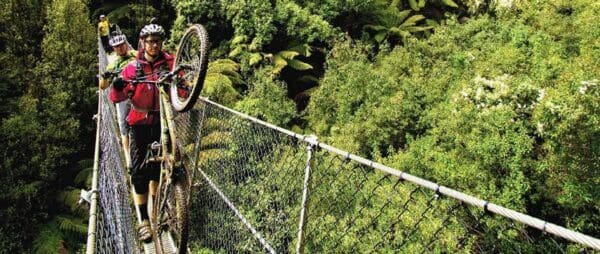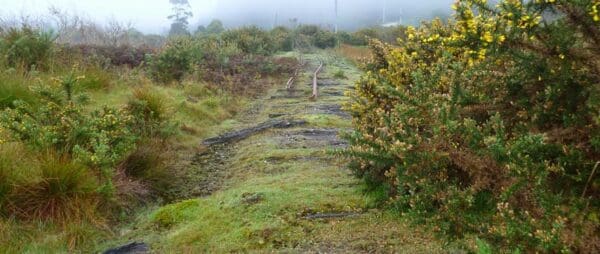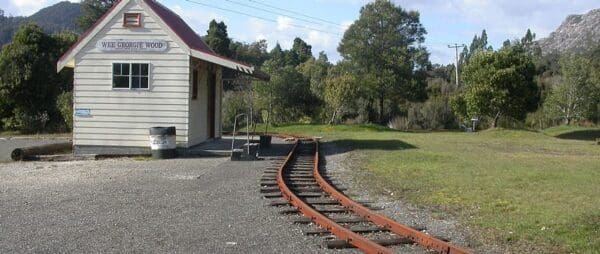This hike is classified as Grade 3 (Moderate) primarily due to its distance exceeding 10km. The terrain itself is relatively easy and suitable for most abilities. However, the longer distance requires some stamina. Feel free to turn back at any point for a shorter adventure.
The Montezuma Falls are the highest in Tasmania and are truly spectacular and well worth the visit. They are certainly amongst the most spectacular waterfalls in Australia. The walk is along a path originally used for trams, and is therefore pretty well flat and an easy grade. The bush is very beautiful as well.
Walking from Williamsford, the track is almost entirely through pleasant and open park-like rainforest. This includes leatherwood, myrtle, sassafras, giant tree ferns and eye-catching fungi.
You're sure to get close to several different birds along the way, notably White's thrush, which is a medium-sized and speckled brown and white ground dwelling bird. It forages quietly on the rainforest floor and, when disturbed, flies only a short distance before settling again, enabling you to get a second look.
When you arrive at the falls there is a short track to the left to view the base, or you can take the swing bridge. Both viewpoints are worth taking and provide spectacular views. Once you have finished gasping at the falls, return along the same way you came.
If you are in the area you should not miss these falls. They are well worth travelling to as a day trip from Cradle Mountain or Strahan/Queenstown.
A 1890 mineral survey showed the falls marked as Osbourne Falls. Montezuma was the name of the last Aztec emperor of Mexico (1466-1520). In Tasmania, his name appears to have originally been applied to a mining company — the Montezuma Silver Mining Company, which was formed in 1891 and held leases on the northern slopes of Mount Dundas.
The creek immediately below the falls was once spanned by a wooden trestle bridge that was 160 ft. long and 50 ft. high and took five months to build. Today derelict pieces of timber, moss-covered concrete piers and rusty bolts are the only remains of this bridge.
The North East Dundas Tramway that ran from Zeehan to Deep Lead (now Williamsford) was constructed to facilitate access to mining sites in the Mount Dundas and Mount Read areas.
Surveying of the line commenced in 1895, and the ceremony to mark the 'turning of the first sod’ was performed on 17 January 1896 before a crowd of 500 people. By January 1897 the first five miles of the line were in use and the official opening of the line through to Williamford was held in June 1898.
The gauge was 2 ft., which was a relatively narrow gauge and explains why the line was known as a tramway rather than a railway. The narrowness of the gauge was chosen to suit the winding hillsides and also to assist in lowering the cost of construction.
The line continued to operate infrequently until 1925 and was officially closed on 4 July 1932 and the rails were removed in the early 1940s.
- Bring a rain jacket, as the spray from the falls is considerable.
- Try time it for a rainy day, it is worth it.
Grade 3 (Moderate) - Walks for Most Fitness Levels: Grade 3 on the
AWTGS represents moderate walking tracks. These are ideal for walkers with some fitness who are comfortable with some hills and uneven terrain. While suitable for most ages, some bushwalking experience is recommended to ensure a safe and enjoyable experience. Tracks may have short, steep hill sections, a rough surface, and many steps. The total distance of a Grade 3 walk can be up to 20 kilometers.
Total distance: 11956 m
Max elevation: 349 m
Min elevation: 261 m
Total climbing: 958 m
Total descent: -966 m
Content use
Please don’t copy GPX files or content from this site to AllTrails or other platforms. Each trail has been personally mapped, documented, and refined to support Australia’s bushwalking and hiking community. While some details come from land managers, every listing reflects significant personal effort. This is a free, community-driven initiative—your respect helps keep it that way.
Getting there
Getting to the trailhead: West Coast Range.
From Queenstown head north on A10 towards Rosebery for roughly 50km. A couple of km before Rosebery take the right turn to Williamsford, Montezuma Falls is sign posted here. Follow this road for roughly 6km to reach the carpark. The road is mostly gravel.
Need a rental car to get you to the hike? Find one here.
Let someone know
Heading out? Fill in a trip intentions form so someone knows your plans. If things go wrong, they can raise the alarm fast, giving you peace of mind on the trail.
Similar walks nearby
Looking for more walks in or near West Coast Range? Try these trails with a similar difficulty grade.
Favourite

Favourite

Favourite

Favourite

Explore safe
Plan ahead and hike safely! Carry enough water, pack layers for changing conditions, and bring safety gear like a torch, PLB, and reliable communication device. Check official sources for trail updates, closures, and access requirements, and review local weather and bushfire advice. Most importantly, share your plans with someone before you go. Being prepared makes for a safer and more enjoyable hike! Stay Safe, Explore More, and Always #ExploreSafe.
Packing checklists
What you carry in your pack depends on factors like weather, terrain, and your adventure type. Not sure what to bring? My free planning, food, and packing checklists are a great starting point, covering day hikes, overnight trips, and multi-day adventures. Use them to customise your kit and always prioritise safety.
Suggest an edit
Notice something different about this trail? Whether it’s a new feature, a route change, or a closure, share your update so we can keep our info accurate and helpful for fellow hikers.
Click to suggest edits >>
/Montezuma-Falls-Hike_12.jpg)
/Montezuma-Falls-Hike_30.jpg)
/Montezuma-Falls-Hike_1.jpg)
/Montezuma-Falls-Hike_40.jpg)
/Montezuma-Falls-Hike_22.jpg)
/Montezuma-Falls-Hike_44.jpg)
/Montezuma-Falls-Hike_41.jpg)
/Montezuma-Falls-Hike_32.jpg)
/Montezuma-Falls-Hike_24.jpg)
/Montezuma-Falls-Hike_31.jpg)
/Montezuma-Falls-Hike_17.jpg)
/Montezuma-Falls-Hike_19.jpg)
/Montezuma-Falls-Hike_35.jpg)
/Montezuma-Falls-Hike_42.jpg)
/Montezuma-Falls-Hike_26.jpg)






